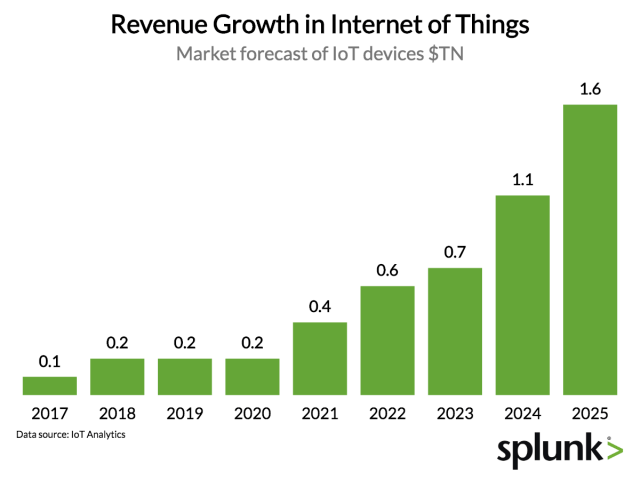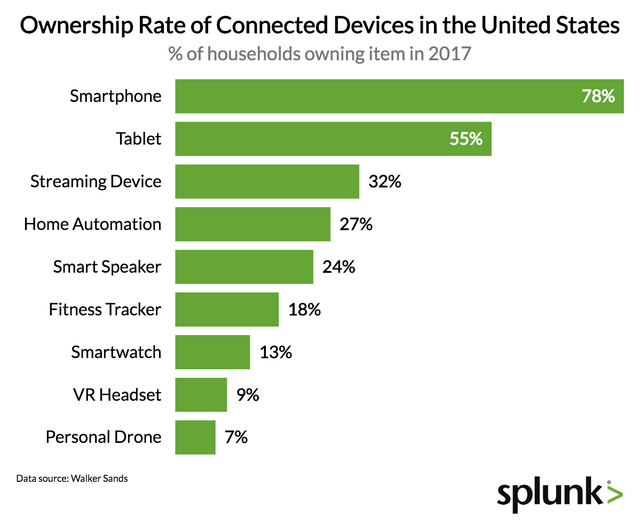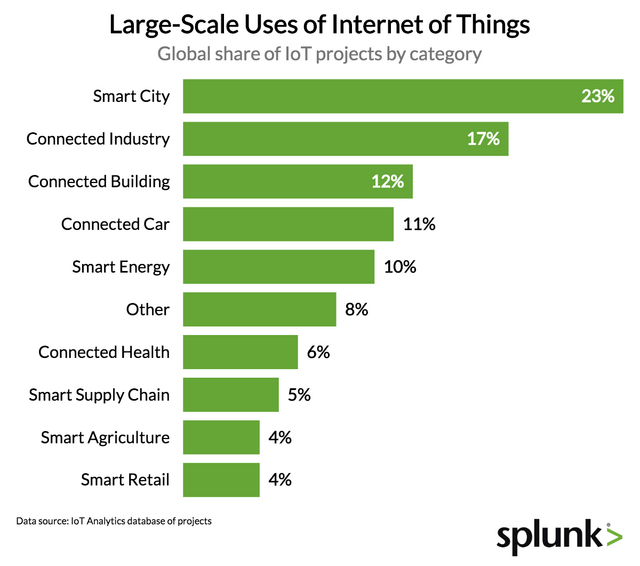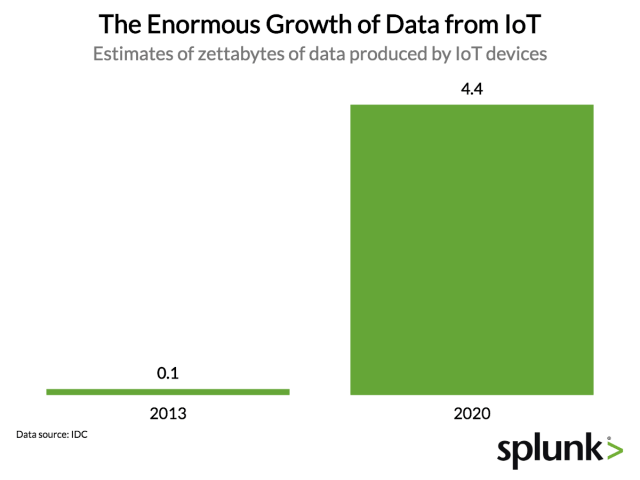This post is from Splunk, a Priceonomics Data Studio customer. Does your company have interesting data? Become a Priceonomics customer.
***
A decade ago, it likely seemed unthinkable that our refrigerators could tell us when we were running low on milk, our doorbells could record our visitors, and our audio speaker system could also “accidentally” order toys online. And yet, here we are in the era of the “Internet of Things”, sometimes abbreviated as IoT, where these sorts of devices have exploded in popularity and are literally everywhere.
The Internet of Things typically refers to adding network connectivity to everyday objects or devices that previously were not internet-enabled. As Tony Fadell, founder IoT trailblazing company Nest commented, a hallmark of the Internet of Things space is to work on “unloved” and sometimes “utilitarian” devices (think smoke detectors, doorbells, and other sensors) and add never-before-possible functionality via network connectivity.
And while consumer IoT has received a lot of attention with the prevalence of smart speakers, televisions, and household appliances, the Internet of Things has also arrived at the enterprise as companies are using the internet to track expensive assets and optimize logistics and manufacturing.
The growth of Internet of Things in terms of number of devices, revenue generated, and data produced has been stunning, but most predictions expect that growth to accelerate. The number of connected devices is expected to grow to 50 billion in 2020 (from 8.7 billion in 2012) and the annual revenue from IoT sales is forecast to hit $1.6 trillion by 2025 (from just $200 billion today).
But perhaps most notable of all, the amount of data produced by Internet of Things is expected to reach 4.4 zettabytes by 2020, from just 0.1 zettabytes in 2013.
***
Before diving into the data, it’s worth spending a moment clarifying what we consider to be an Internet of Things device, and what isn’t. In this report, we adopt the definition that IoT devices are ones that were traditionally not connected to the internet (“dumb” devices), but are now network connected, enabling a new set of applications.
For example, even though smartphone phones and computers are Internet-enabled, we don’t consider them as IoT devices because they “traditionally” have been so. At the other end of the extreme, an internet-enabled toaster oven would be considered an Internet of Things device in this report because that appliance hasn’t typically been connected to a network.
With that definition in mind, just how fast is the IoT market growing? With any market forecast, there are a number of competing statistics and predictions, but all of them indicate the growth has been blazing fast and may even accelerate.
According to the NCTA, the trade association for broadband and television providers, the installed base of connected devices is expected to grow to over 50 billion by 2020, an increase of almost 500% from 2012.

Nearly every market forecast shows the industry growing to a trillion dollar plus industry in the next decade. One of the more conservative estimates from market research firm IoT Analytics pegs it growing to a $1.6 trillion industry by 2025.

If $1.6 trillion in revenue by 2025 seems like an aggressive estimate, keep in mind that by that year, McKinsey estimates the market to reach $6.1 trillion, IDC estimates $7.1 trillion and Cisco estimates $14.4 trillion.
How can a market grow from relatively small to a multi-trillion dollar industry within a decade? Given that the ambition of Internet of Things is to replace every asset in the economy with a networked-replacement, the industry is targeting a very large market.
Consumer Vs. Enterprise Landscape
Not only is IoT a very large market, but it targets both consumer and enterprise devices and applications. While consumer IoT devices often get most of the attention in the popular press, enterprise IoT has the potential to transform the operations of nearly every industry in the economy.
On the consumer side, what are the most popular IoT devices? A report by market research firm Walker Sands shows the ownership rate of various connected devices among U.S. households in 2017. While not strictly part of the “Internet of Things,” smartphones and tablets are included in the chart below for reference.

Though no nowhere near as popular as smartphones and tablets, the most popular IoT devices of streaming device, home automation, and smart speaker are found in over 20% of homes in the United States.
Part of what makes predicting the size of the IoT market difficult is that some of the categories are growing at tremendous rates. Take smart speakers, for example, a category that barely existed a few years ago may sell 56 million units in 2018, eight times more than their 2016 sales, as tech giants Amazon, Google and Apple have jumped into what has become a huge category.

Smart speakers may stand out as an exceptionally fast growing category, but it’s not alone. Televisions for example, have gone from “dumb” screen monitors to ones that can play internet video via direct capability or through a streaming device in less than a decade. There is strong reason to believe that in the future, nearly all consumer devices that could be connected to the internet, will.
In the enterprise, the promise of greater efficiency gains from IoT, is part of what is underlying the predictions of why IoT could be a multi-trillion dollar industry in the next decade. Thirty years ago, understanding where your assets where, what they were doing, and what was wrong was them would have been cost prohibitive. Today, given the proliferation of low cost sensors and internet connectivity, this kind of knowledge is commonplace.
There are three main use cases for the Internet of Things in the enterprise:
- Monitoring and Diagnostics: Improved machine availability with real-time monitoring and diagnostics.
- Predictive Maintenance: Get notifications and diagnose alarms and anomalies in real-time to accelerate issue response without affecting production.
- Industrial Security: Find the source of security problems before equipment fails and avoid the costly downtime associated with breaches.
Beyond individual companies embracing the Internet of Things, we’re also seeing large scale industrial projects with IoT at their core. Research firm IoT Analytics, compiled a list of 1,600 known industrial IoT projects and categorized them according to these segments:

The largest category of industrial IoT is Smart City, which often involves projects involving traffic monitoring, parking management, and other applications that give governments analytics into the workings of their cities. Rounding out the top three industrial IoT use cases are Connect Industry (IoT devices in non-factory environments like a mining operation) and Connect Buildings (typically using monitoring to make building energy use more efficient).
The Data Cometh
Whether it’s for the consumer, enterprise or industrial, IoT devices by their very nature produce an enormous amount of data. As would be expected given the steep expected growth of the IoT market, the amount of data that will be generated by the Internet of Things will be truly enormous.
According to IDC, the data generated from IoT devices is currently growing from 0.1 zettabytes in 2013 to 4.4 zettabytes in 2020:

By this estimate, data generated by IoT devices in increasing nearly 50 times in just seven years, posing some spectacular challenges for the companies tasked with being stewards for this data.
IoT executive Steve Wilkes highlights the three main problems companies face in light of this IoT data explosion:
-
Data Integration: Using this newly created IoT data in concert with other enterprise data sources like log files, message cues, and transactional data.
-
Managing Data: Currently, there isn’t enough storage in the entire world to meet the future expected data storage needs from IoT devices. Creating a data management process to decide what data to store and how to access it for analysis will pose major decisions for these companies.
-
Data Security: IoT devices captures highly personal data from consumers and highly proprietary data from enterprises. As the last decade of high profile hacks has demonstrated–where there is data, there is bound to be people trying to steal that data.
Conclusion
By all accounts, the growth of IoT has been exponential. The market is expected to grow from a couple of hundred billion dollars to over a trillion dollars in under a decade. A category like smart speakers, which was a small niche a few years ago, is now a ubiquitous presence in homes across the world. And as companies invest in capital improvements, those assets are increasingly equipped with internet capability to monitoring, maintenance and optimization purposes.
The Internet of Things revolution is here and it’s only getting bigger. And that means one enormous by product from all these connected devices: data. The companies that create and deploy IoT devices will increasingly find themselves pondering not just how to use IoT devices but what to do with the data and how to secure it from threats.
***
Splunk Inc. turns machine data into answers with the leading platform to tackle the toughest IT, IoT and security challenges. See how to get real-time and predictive insights from your industrial operational data with a free version of Splunk.




